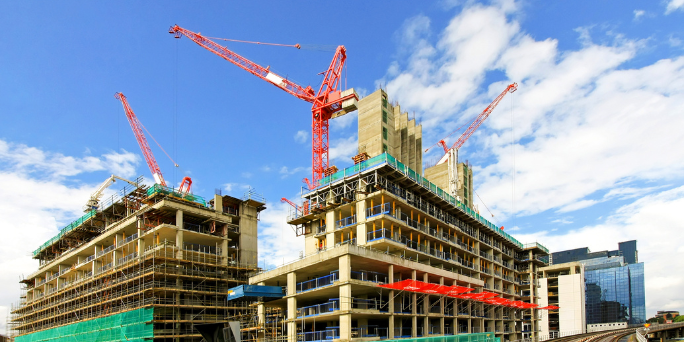It’s been a challenging couple of years for the construction industry.
In 2020, Brexit contributed to an already worsening labour shortage and the delay of certain building materials. The COVID-19 pandemic exacerbated these delays, resulting in the almost complete shutdown of the global logistics industry and, more recently, delays in freight shipping have caused further disruption.
But against the backdrop of these challenges, the UK construction industry has remained resilient and powered through. Only in January 2022 did the ONS report that construction activity had returned to pre-pandemic levels after rebounding by 12.7%.
Whilst this may hint at the return to some level of normality, the Russian invasion of Ukraine suggests otherwise. The impact the war is having both on the people of Ukraine and on the global economy is significant. The war has – and for the foreseeable future will – continue to lead to supply chain disruption and pose further challenges to the UK construction industry.
Following Russia’s invasion of Ukraine, material prices shot up with bricks, timber, and steel seeing some of the highest increases. With Russia being a major supplier of these materials, sanctions placed on the country have caused increasing disruption to international trade flows. Russian owned “Rusal” remains one of the largest aluminium producers which, due to sanctions, means around 12% of the worlds global aluminium supplies have been directly disrupted.
Further calls to cease trading with Russia completely have led to continued uncertainty around the supply of materials. A recent decision by the Programme for the Endorsement of Forest Certification (PEFC) to brand all timber originating from Russia and Belarus as “conflict timber” is anticipated to fuel timber delays, whilst the Timber Trade Federations recommendation to completely avoid purchases from both countries is expected to add to this.

Despite a challenging two years, construction activity returned to pre-pandemic levels in January. January 2022 did the ONS report that construction activity had returned to pre-pandemic levels after rebounding by 12.7%
Additional challenges should be expected. With restrictions on Russian gas flows to European producers, further disruption is likely to be seen. The energy-intensive production of steel and aluminium make it vulnerable to increases in energy prices which, added to increasing inflation (a 9% increase in the last 12 months), is expected to lead to substantial increases in the cost of steel.
The same applies to the brickmaking industry in Europe which is already running at capacity in terms of production. Any increases in cost could affect exports to the UK and further impact the UK construction industry. With Ukraine itself being a supplier of bricks and steel, and being one of the largest producers of iron, for as long as the war continues disruption should be expected.
There has never been a more pressing time to invest into the resilience of supply chains. Brexit, the COVID-19 pandemic, and the continued uncertainty surrounding the war in Ukraine demonstrate why this is. Whilst the Construction Leadership Council (CLC) are expected to provide guidance to the construction industry on how these challenges can be addressed, several key steps can be taken to increase supply chain resilience.
Firstly, ensure that you’re keeping up to date with the situation, the price of materials and supply chain disruptions. Remember to consider inflation within the construction industry when developing proposals, as well as the broader inflation we’re seeing in everyday life. You can draft work specifications more broadly to allow flexibility to contractors and subcontractors when procuring materials. Good client communication is also key: setting up regular channels of communication and frequently discussing the situation with clients, contractors and suppliers can allow disruptions to be worked around.
Perform a risk mapping exercise to identify the materials used in projects most at risk of delays and/or price increases. This does not have to be time consuming or expensive and free resources on how to perform risk mapping exist: The Supply Chain Sustainability School provides free access to resources that explain how to perform a risk mapping exercise and identify risk spots in your supply chain.
Once you’ve performed a risk mapping exercise, consider what options exist for high-risk materials; for example, with the ban on timber from Russia and Belarus, can a more diverse supply chain be created in which more local suppliers can be identified? You can explore possible solutions here to identify both local and recycled timber suppliers.
As the Russian invasion of Ukraine continues to cause devastation to the people of the country and disruption to global supply chains, the UK construction industry is remaining resilient. Over 2022 the output of the industry is expected to continue growing by a robust 4.3% (Construction Products Association, 2022). Growth of the industry was recorded in the past despite Brexit and the COVID-19 pandemic and has the resilience to overcome the disruption caused by the Ukraine conflict. With supply chain disruption becoming more common however, attempting to create a more flexible supply chain that can adapt to these disruptions will support growth in the long-term.
For further resources on how to improve the resilience of your supply chain you can watch this video and access several other resources, for free, at the Supply Chain Sustainability School.

Sam Walker
Consultant Researcher
sam.walker@actionsustainability.com

This was posted in All Topics, Energy & Carbon, ISO 20400 Sustainable Procurement
Our Head of Climate, Dr James Cadman, shares his insights on how organisations can effectively embed carbon reduction into their sustainable procurement practices using the ISO 20400 framework.
Read Article
This was posted in ISO 20400 Sustainable Procurement
Addressing procurement barriers is essential for harnessing the full potential of SMEs in the UK. Consultant, Sarah Chatfield explores the barriers to procurement which SMEs in the UK face and the vital role they play within the economy.
Read Article
This was posted in Energy & Carbon, ISO 20400 Sustainable Procurement
Developed by Action Sustainability, "Responsible Sourcing of HVO – A Comprehensive Guide" explores how to responsibly procure Hydrotreated Vegetable Oil (HVO).
Read Article